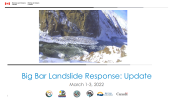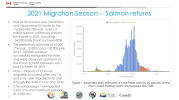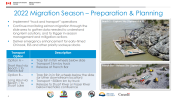Thanks Brian. Funny how our standards change over the years, 54k total last year while in the early 90’s I remember one year when nearly a million returned … 250k to the Driftwood alone. As it is now their survival hinges on favorable water conditions but realistically this population has always had migratory issues.Actually Dave, Early Stuarts did better than the preseason estimate.
You are using an out of date browser. It may not display this or other websites correctly.
You should upgrade or use an alternative browser.
You should upgrade or use an alternative browser.
Rock slide in Fraser River, B.C., may hinder salmon passage
- Thread starter wildmanyeah
- Start date
Well I guess with the way things have evolved with the DFO we can only hope for optimal water conditions.Thanks Brian. Funny how our standards change over the years, 54k total last year while in the early 90’s I remember one year when nearly a million returned … 250k to the Driftwood alone. As it is now their survival hinges on favorable water conditions but realistically this population has always had migratory issues.
Hope they get their act together before it doesn’t matter anymore.
Nobody cares because most of the anglers have not been around fish for the these stocks. They dont even know that we used to have a May Chinook fishery on the Fraser and even earlier. Now anglers are more concerned about making youtube videos or weighing in 5lb runts in the hero Steelhead derby.
The part that is even more sad is none of the tackle stores are even talking about this. Or others with social media platforms that could be bringing awareness to these upper stocks that will be extinct very soon.
Much like our IFS these stocks are doomed.
The part that is even more sad is none of the tackle stores are even talking about this. Or others with social media platforms that could be bringing awareness to these upper stocks that will be extinct very soon.
Much like our IFS these stocks are doomed.
Last edited:
Derby
Crew Member
any word on the fish ladder?Actually Dave, Early Stuarts did better than the preseason estimate.
That was the purpose of my post Derby, there does not appear to any progress on this.any word on the fish ladder?
Brian Klassen
Member
Word I have received thru my contacts say that several of the FN are having reservations about a fish ladder so everything is being delayed to "discuss" options and plans.any word on the fish ladder?
While it's desirable to have natural passage it all depends on flow conditions, especially for the early stocks. My position is just build the damn thing.
screaminreels
Active Member
How can there be any reservations about a ladder. Without the outcome is pretty obvious can't see the forest for the trees.
wildmanyeah
Crew Member
Transporting fish the 500 k is not really the problem, assuming adequate procedures. The issue is the stress on the fish from capture and handling. Consider, if the water is high enough to warrant transporting, that means the fish would have had a difficult time getting by Saddle Rock and Hells Gate, meaning stress hormones will be raging when finally captured for transport.Transporting 500km seems extreme. Does anyone have any knowledge or data that this has been done before.
Also, does anyone know what the second phase will consist of.
Thanks,
I would like to see both options considered if necessary.
wildmanyeah
Crew Member
Big Bar landslide response information bulletin
April 11 2022On this page
- Sockeye and Chinook fry are almost ready for release while other operational work is underway
- Snowpack and river conditions
- Hydrographic and bathymetric work at Big Bar
- Current images of work being done at the landslide site
Sockeye and Chinook fry are almost ready for release while other operational work is underway
Enhancement update
Over the winter months, sockeye and Chinook gametes have evolved from eggs into fry and will be ready for release into their natal streams beginning in late April and continuing into the summer. These juvenile salmonids are the progeny of the brood stock that was collected during the 2021 Big Bar emergency conservation program. The salmon release is a joint effort with DFO’s Salmonid Enhancement Program (SEP), the Upper Fraser Fisheries Conservation Alliance, Takla Nation, Nak’azdli First Nation and the Spruce City Wildlife Association.Juvenile sockeye have been reared at four separate locations: two DFO SEP hatcheries and two facilities owned and operated by Takla Nation and the Nak’azdli First Nation. The juvenile Chinook are being reared at a DFO SEP facility, the University of Northern British Columbia’s Quesnel River Research Centre, and the Spruce City Wildlife Association located in Prince George.
In total, 690,000 sockeye and 320,000 Chinook will be released in 2022, including four different populations of sockeye and 13 populations of Chinook. Most of the releases will occur between late April and mid-June with an additional release in late September. Three groups of Chinook will be held back an additional year to be released as smolts in 2023.
Identifying optimal release locations and transport methods has been a critical undertaking. Although most fry will be released by truck, helicopters will be used in some cases due to a lack of road access. This method will also ensure the fry are deposited in optimal habitat conditions.
Snowpack and river conditions
DFO’s environmental watch (EWATCH) program interprets the critical information provided by the BC River Forecast Centre on snowpack and river conditions to determine whether those conditions could cause passage issues for some salmon, especially early-timed sockeye.As of April 1st, snowpack levels in the Fraser River watershed decreased slightly from March 1st, and are in the moderate to slightly high range. The Chilcotin is at 72% of normal, Upper Fraser East is 117% of normal, while Quesnel is 116% of normal and the North Thompson is 119% of normal. Snow pack levels are just one factor that determines freshet flows. Ambient spring temperatures, presence/absence of rain, and prolonged early heat are all factors which affect the timing, magnitude and duration of freshet.
Areas with larger snowpacks may contribute to greater flows for the Fraser River. Spring temperatures between April and mid-June 2022 will shape the impact on salmon migration. Data in the Basin Snow Water Index, managed by the Ministry of Environment and Climate Change, showed lower than average snow levels for March 2022, 2021 and 2022. The key areas causing higher freshets at Big Bar are the Upper Fraser East, Upper Fraser West, Quesnel and Nechako. Although the Chilcotin River poses a concern for sediment and localized flooding, it does not contribute significantly to the overall Fraser River discharge at freshet. The Chilcotin River area will be monitored if snowpack levels increase.
Updated information can be found on the River Forecast Centre website.
Hydrographic and bathymetric work at Big Bar
In March 2022, local First Nations and researchers from Simon Fraser University (SFU) met on-site at Big Bar to collaborate on the Fraser River Landslide Research project, which is supported by the BC Salmon Restoration and Innovation Fund (BCSRIF). SFU and its partners used sonar equipment to survey areas above and below the slide to acquire more detailed bathymetry. Other work included capturing river flow velocities in the canyon in order to validate the velocity data that is regularly calculated using local cameras that can derive the speed of moving water.Road conditions made field access challenging, but perseverance and impressive logistical organization yielded successful field work.
The Fraser Salmon Management Council provides Indigenous liaison support to the project team for the First Nations engagement component, which is critical to the project’s success. The Big Bar tripartite governance partnership model is a key example of how inclusive, open and transparent teamwork benefits collaborative projects like the BCSRIF Fraser River Landslides Research effort.
Current images of work being done at the landslide site
 Early Stuart fry transfer, Dec 2020. Click to enlarge.
Early Stuart fry transfer, Dec 2020. Click to enlarge.Additional images of the work underway as part of our response efforts can be seen on the Government of BC’s Flickr channel.

B.C. fish are making a splash after newfound freedom - The Weather Network
Physical barriers can prevent fish from accessing habitat needed for all stages of their life cycle, a prevalent issue in B.C. that prompted the provincial government and conservation groups to step in to resolve.
Not sure if this old news or not. But a good story.
Hopefully a gradual steady melt this year. Not sure what percent of normal the Fraser Snowpack is at this year but I think they were still getting some late season accumulations. I’m close to the end of the river and it’s quite brown already.Any news on this?
Its almost mid May....there would have been springs passing through the slide now for over 6 weeks at least.
donnie d
Well-Known Member
Water level was below 1500m3/s for April but has gone up to around 3300m3/s in recent days. I would think any Chinook approaching would be just fine. Cool weather may bring it down slightly over the next few days? Looks to have temporarily stalled the spike up. I believe Chinook passage can still occur up to 3500. After assistance is likely required.Hopefully a gradual steady melt this year. Not sure what percent of normal the Fraser Snowpack is at this year but I think they were still getting some late season accumulations. I’m close to the end of the river and it’s quite brown already.
donnie d
Well-Known Member
Shame the hydro acoustic monitoring is not in place?? Or perhaps just not being reported? I guess at this point we shouldn’t be surprised.Any news on this?
Its almost mid May....there would have been springs passing through the slide now for over 6 weeks at least.
Similar threads
- Replies
- 8
- Views
- 777
- Replies
- 0
- Views
- 333
- Replies
- 3
- Views
- 1K
- Replies
- 0
- Views
- 752





